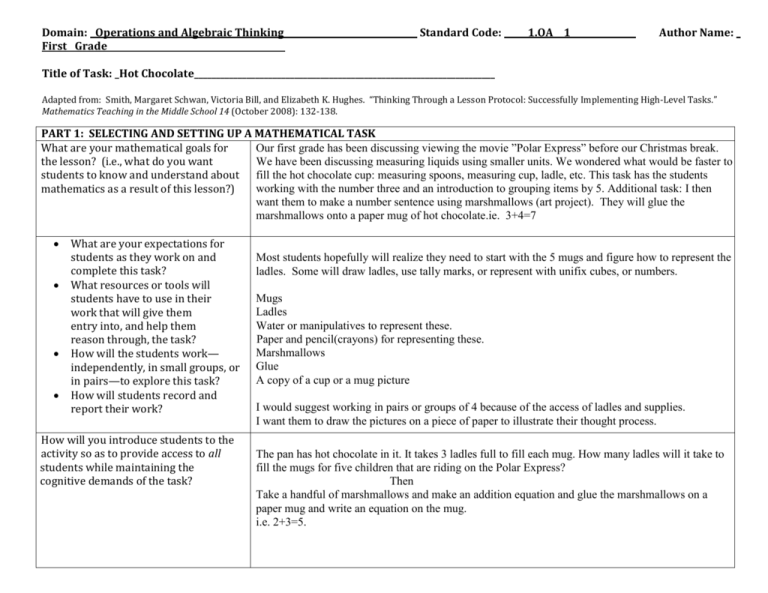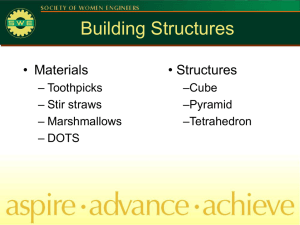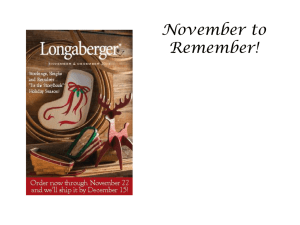Thinking Through a Lesson Protocol (TTLP) Template
advertisement

Domain: Operations and Algebraic Thinking First Grade Standard Code: 1.OA 1 Author Name: Title of Task: _Hot Chocolate_____________________________________________________________________ Adapted from: Smith, Margaret Schwan, Victoria Bill, and Elizabeth K. Hughes. “Thinking Through a Lesson Protocol: Successfully Implementing High-Level Tasks.” Mathematics Teaching in the Middle School 14 (October 2008): 132-138. PART 1: SELECTING AND SETTING UP A MATHEMATICAL TASK Our first grade has been discussing viewing the movie ”Polar Express” before our Christmas break. What are your mathematical goals for We have been discussing measuring liquids using smaller units. We wondered what would be faster to the lesson? (i.e., what do you want students to know and understand about fill the hot chocolate cup: measuring spoons, measuring cup, ladle, etc. This task has the students working with the number three and an introduction to grouping items by 5. Additional task: I then mathematics as a result of this lesson?) want them to make a number sentence using marshmallows (art project). They will glue the marshmallows onto a paper mug of hot chocolate.ie. 3+4=7 What are your expectations for students as they work on and complete this task? What resources or tools will students have to use in their work that will give them entry into, and help them reason through, the task? How will the students work— independently, in small groups, or in pairs—to explore this task? How will students record and report their work? How will you introduce students to the activity so as to provide access to all students while maintaining the cognitive demands of the task? Most students hopefully will realize they need to start with the 5 mugs and figure how to represent the ladles. Some will draw ladles, use tally marks, or represent with unifix cubes, or numbers. Mugs Ladles Water or manipulatives to represent these. Paper and pencil(crayons) for representing these. Marshmallows Glue A copy of a cup or a mug picture I would suggest working in pairs or groups of 4 because of the access of ladles and supplies. I want them to draw the pictures on a piece of paper to illustrate their thought process. The pan has hot chocolate in it. It takes 3 ladles full to fill each mug. How many ladles will it take to fill the mugs for five children that are riding on the Polar Express? Then Take a handful of marshmallows and make an addition equation and glue the marshmallows on a paper mug and write an equation on the mug. i.e. 2+3=5. PART 2: SUPPORTING STUDENTS’ EXPLORATION OF THE TASK As students work independently or in Getting Started Questions: small groups, what questions will you How are you going to figure this out? What information do you have? What is your plan? ask to— What can you use that you already know? How can we show how many ladles we will need for help a group get started or make each mug. progress on the task? focus students’ thinking on the Focus questions: key mathematical ideas in the Why did you start with the 5 cups? How many ladles in each cup? How can you represent this in task? assess students’ understanding of your drawing? If you use unifix cubes, how can these help? Can you see a pattern with 3’s? Is key mathematical ideas, problem- there another way? Can you use addition to help you? Skip counting? solving strategies, or the Assessing Questions: representations? advance students’ understanding Will you explain that to me? Is each portion equal? How did you add that? What did you use to come to that answer? of the mathematical ideas? Advanced Questions: Is there another way to come up with an answer? How many ladles would you use if you had 10 mugs? How will you ensure that students remain engaged in the task? What assistance will you give or what questions will you ask a student (or group) who becomes quickly frustrated and requests more direction and guidance is solving the task? What will you do if a student (or group) finishes the task almost immediately? How will you extend the task so as to provide additional challenge? Extensions: Add 10 mugs to the problem. How many ladles used for the mugs for the whole classroom? Provide an art project where the student will take less than 10 marshmallows and make a number sentence using the marshmallows. The student will glue the marshmallows on the mug and write the sentence on the mug itself. PART 3: SHARING AND DISCUSSING THE TASK Specific Questions: How will you orchestrate the class Can you explain your thinking? discussion so that you accomplish your What do your drawings show? mathematical goals? Do you see a pattern? Which solution paths do you want Can you figure how many more ladles needed if you added 2 more mugs? 5 more? 10 more? to have shared during the class discussion? In what order will the solutions be presented? Why? What specific questions will you ask so that students will— 1. make sense of the mathematical ideas that you What will you see or hear? want them to learn? They have pictures drawn representing the mugs and the ladles or representations of unifix 2. expand on, debate, and question cubes in the mugs. the solutions being shared? Their work is clear and precise. 3. make connections among the Students will be sharing work with the partners and with the class. different strategies that are The students will be explaining how the mugs are equal. presented? 4. look for patterns? 5. begin to form generalizations? What will you see or hear that lets you know that all students in the class understand the mathematical ideas that you intended for them to learn?






